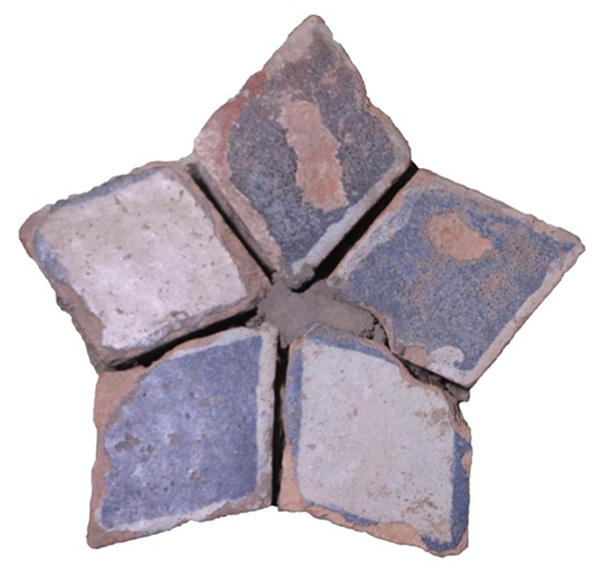The Buddhist Decorative Glazed Tiles of Mrauk U: The Arakanese Appropriation of Islamic Glazed Tiling | မြောက်ဦးမြို့ရှိ ဗုဒ္ဓသာသနိက အလှဆင် စဉ့်ချပ်များ အစ္စလမ်မစ် စဉ့်ချပ်အလှဆင်မှုဓလေ့ကို ရခိုင့်ဒေသယဉ်ကျေးမှုနှင့်လိုက်ဖက်စွာ ပြန်လည်အသုံးချမှု
DOI:
https://doi.org/10.26721/spafajournal.2021.5.659Keywords:
Glazed tile, Islamic tiling, Ceramics, Arakan, Bengal, ရခိုင်, ဘင်္ဂလား, စ????့်၊, အစ????လမ်မစ် စ????့်ချပ်အလှဆင်မ????, ေြမာက်ဦးAbstract
Mrauk U is situated in the western part of modern Myanmar and was the capital of Arakan (Rakhine) from 1430 CE until the Burmese conquest in 1784 CE. Its unique position in the Bay of Bengal via the Kaladan river and its tributaries resulted in the development of a commercial and cultural center in its heyday. European travel accounts and chronicles describe Mrauk U as a prosperous cosmopolitan city with a polyglot court, not only using native Arakanese language but also Persian and Bengali. Consequently, the remnants of art and archaeology reveal that the artisans drew much of their inspiration from Indian, European and Burmese traditions (Gutman 2001; 2002; Leider 2002:83). This paper contextualizes decorative glazed tiles of Arakanese Buddhist monuments in relation to the historical, political and cultural situation of Mrauk U. Regional interaction will be taken into account to identify the origins and development of Arakanese glazing technology. Previous research has mainly focused on the art and architecture of the Mrauk U period and the origin of the glazing technique remains vague. The comparative analysis reveals that significant elements in Arakanese glazing art, such as the use of stylized, geometric, floral or vegetal designs and animal poses seem to be borrowed from Islamic art. This article argues that Islamic tile tradition exerted considerable influence on the Arakanese glazing technique, probably via Bengal.
မြန်မာနိုင်ငံ အနောက်ဖက်ပိုင်းတွင်တည်ရှိသော မြောက်ဦးမြို့သည် 1430 AD မှစ၍ 1784 AD ဗမာမင်းများ သိမ်းပိုက်ခဲ့သည့်အချိန်တိုင်အောင် ရခိုင်လူမျိုးတို့၏ မြို့တော်ဖြစ်ခဲ့ပါသည်။ ဥရောပ ခရီးသွားမှတ်တမ်းများနှင့် ရာဇဝင်များတွင် ဖော်ပြချက်များအရ မြောက်ဦးသည် လူမျိုးပေါင်းစုံ အခြေချနေထိုင်ပီး မိခင် ရခိုင့်ဘာသာစကား သာမက ပါရှန်းနှင့် င်္ဘဂါလီဘာသာစကားများပါ အသုံးပြုသော နန်းတော်တည်ရှိရာမြို့လည်း ဖြစ်သည်။ ၎င်း၏ အကျိုးဆက် အနေဖြင့် မြောက်ဦးမြို့ရှိ ကျွင်းကျန်ရစ်သော ရှေးဟောင်သုတေသနနှင့် အနုပညာလက်ရာများသည် အိန္ဒိယ၊ ဥရောပ နှင့် မြန်မာ့ယဉ်ကျေးမှုဟန်များ ရောယှက်လျက်ရှိပါသည်။ ယခုစာတမ်းသည် မြောက်ဦးမြို့ရှိ ဗုဒ္ဓသာသနိက အဆောက်အဦးများတွင် အလှဆင်ထားသော စဉ့်ချပ်များအကြောင်းကို မြောက်ဦးခေတ် သမိုင်း၊ နိုင်ငံရေးနှင့် ယဉ်ကျေးမှု အခြေအနေများနှင့် ချိန်ထိုး၍ လေ့လာသွားမည်ဖြစ်သည်။ စဉ့်ပြုလုပ်သည့် အတတ်ပညာကို မည်သို့ မည်ပုံ ကျွမ်းကျင်တတ်မြောက်ခဲ့ကြောင်းကို ဒေသတွင်းအခြား ခေတ်ပြိုင် စဉ့်လုပ်ငန်းများနှင့် ချင့်ချိန် လေ့လာသွားပါမည်။ ယခင်လေ့လာခဲ့သော သုတေသနများသည် မြောက်ဦးခေတ် ဗိသုကာနှင့် အနုပညာရပ်များအပေါ် အဓိကဇောင်းပေးခဲ့ပီး စဉ့်အတတ်ပညာမည်သို့ ရရှိတတ်မြောက်ခဲ့ကြောင်း လေ့လာရန်လိုအပ်လျက်ရှိပါသည်။ နှိုင်းယှဉ်လေ့လာ ချက်များအရ ရခိုင် စဉ့်ချပ်များပေါ်ရှိ ပန်းခက်ပန်းနွယ်၊ ဂျီဩမေထြီ ဟန်ပန် ဒီဇိုင်းများနှင့် တိရိစ္ဆာန် ကိုယ်နေဟန်ထား ပုံစံများသည် အစ္စလမ်မစ် အနုပညာ လက်ရာများနှင့် တူညီသော အင်္ဂါရပ်များစွာတွေ့ရပါသည်။ အစ္စလမ်ဘာသာရေး အဆောက်အဦးများတွင် စဉ့်ချပ် အလှဆင်သောဓလေ့သည် မြောက်ဦးစဉ့်ချပ် အလှဆင်မှု ဓလေ့အပေါ်တွင် လွှမ်းမိုးမှုရှိခဲ့ပြီး ၎င်းနည်းပညာမှာ အိန္ဒိယနိုင်ငံ င်္ဘဂလားဒေသမှ ဆင်းသက် လာသည်ဟု ယူဆရ နိုင်ကြောင်းကို ယခုစာတမ်းတွင် ဆွေးနွေးတင်ပြသွားပါမည်။

Downloads
Published
How to Cite
Issue
Section
License
Copyright (c) 2021 SEAMEO SPAFA and Author

This work is licensed under a Creative Commons Attribution-NonCommercial-NoDerivatives 4.0 International License.



